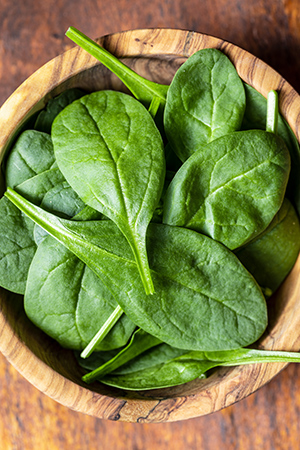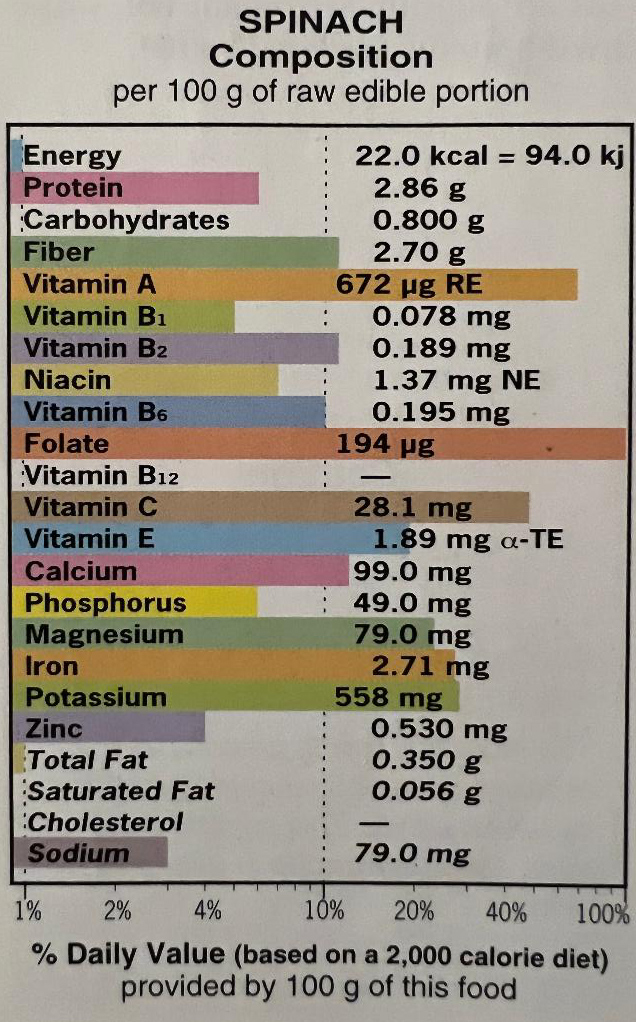Contents
The famous cartoon sailor Popeye was fully aware of the many spinach health benefits and owed his extraordinary strength to this vegetable. Clinical and laboratory investigations corroborate that Popeye was correct in consuming so much spinach for his great power. Besides, new diet therapy functions have been uncovered for this excellent vegetable, such as its defensive properties regarding the retina and vision.

Spinach Scientific Facts
- Scientific name: Spinacia oleracea L.
- French: Épinard.
- Spanish: Espinaca.
- German: Spinat.
- Description: Spinach (‘Spinacia oleracea’ L.) is an herbaceous plant in the botanical family Chenopodiaceae.
- Environment: Originally from western Asia, spinach spread throughout Europe during the Middle Ages. Today, it is cultivated throughout the world, except in the tropics. The central producing countries are the United States, Germany, France, and Italy.
Spinach Health Benefits

Spinach is possibly the most nutritious green leafy vegetable, although it only contains twenty-two calories per one hundred grams. Its protein content is relatively high for a green leafy vegetable (2.86 percent), but it has few carbohydrates (0.8 percent) and fats (0.35 percent).
The nutritional power of spinach derives from its richness in vitamins and minerals, as 100 grams of spinach provides:
- two-thirds (672 ug RE) of the daily need for vitamin A (1,000 ug RE),
- practically all (194 ug) of folic acid or folates needed daily (200 ug),
- half of the vitamin C (28.1 mg) daily required (60 mg),
- almost one-fourth (79 mg) of the daily requirement for magnesium (350 mg),
- more than one-fourth (2.71 mg) of the daily need for iron (10 mg).
Although these data are based on the daily needs of an adult male, as is the case throughout this work, they hint at the great concentration of vitamins and minerals in spinach. These are some of its more critical applications:
Retina disorders – The macula is a small yellow spot about two millimeters across the retina’s center. It parallels the area of highest visual acuity. The degeneration of this susceptible area of the retina is the primary cause of blindness among the elderly.
A detailed investigation at the Massachusetts Eye and Ear Infirmary and Harvard University (USA) shows that people between 55 and 80 who regularly consume spinach present a lower risk of losing visual acuity because of macular degeneration.

The shielding effect of spinach on the retina is superior to that of carrots. This fact has caught scientists’ attention, attributing it to spinach’s exceptional levels of zeaxanthin and lutein. These elements are carotenoid-type vegetable pigments, which, though not transformed to vitamin A, as beta-carotene is, act as powerful antioxidants that shield the delicate cells of the retina. Regular intake of spinach is advised for all who wish to maintain sight, especially those over 50.
Anemia—Spinach contains 2.71 mg of iron per 100 grams, a proportion more significant than that of meat. Although iron from plants is more challenging to absorb than from animal sources, vitamin C in spinach and other foods substantially improves the absorption of this mineral.
Furthermore, spinach is rich in other minerals and trace elements that foster the production of red blood cells within the bone marrow. Fresh spinach juice is an effective way to consume it in cases of anemia.

Elevated cholesterol level—Experiments with animals have shown that spinach proteins inhibit the absorption of cholesterol and bile acids. Regular use aids in reducing blood cholesterol levels.
Pregnancy – Because of its rich folic acid or folate content (194 ug/ 100 grams), which prevents specific fetal malformations, and its antianemic action, spinach health benefits are ideal for pregnant women.
Physical activity and growth – Because of its rich vitamin and mineral content, spinach is highly recommended for athletes and adolescents who engage in physical activities during periods of rapid growth.
Oxalic Acid
Spinach is the richest of all foods in oxalic acid (779 mg/100 grams). When combined with calcium, oxalic acid forms calculi (stones) in the urinary ducts of certain persons predisposed to them.
A healthy person eliminates oxalic acid through the urine without complication. However, people suffering from kidney stones, gout, or excess uric acid should avoid spinach. Since oxalic acid interferes with calcium absorption, spinach should not be eaten with milk or dairy products.
Discarding the water used for cooking reduces spinach’s oxalic acid content. This process removes some of its vitamins and minerals and most of its oxalic acid.
How to use Spinach
- Raw – When spinach is tender, it may be eaten in salads.
- Frozen – Frozen spinach loses a small portion of its vitamin C, but it is available year-round.
- Cooked – The ideal method is steaming, which preserves most of its vitamins and minerals.
- Fresh juice—Half a day sipped before lunch or supper is recommended to fully take advantage of the many spinach health benefits.
DISCLAIMER: All content on this website is presented solely for educational and informational objectives. Do not rely on the information provided as a replacement for advice, diagnosis, or treatment from a qualified medical expert. If you are pregnant, nursing, or have any preexisting medical concerns, talk to your doctor before using any herbal or natural medicines.
REFERENCES
- George D. Pamplona-Roger, M.D. “Encyclopedia of Foods and Their Healing Power.” George D. Pamplona-Roger, M.D. Encyclopedia of Foods and Their Healing Power. Trans. Annette Melgosa. Vol. 2. Chai Wan: Editorial Safeliz, 2005. 28, 29. Print. [Spinach Health Benefits]
- Healthline: https://www.healthline.com/nutrition/foods/spinach
- Medical News Today: https://www.medicalnewstoday.com/articles/270609
- WebMD: https://www.webmd.com/diet/health-benefits-spinach
- Cleveland Clinic: https://health.clevelandclinic.org/benefits-of-spinach
